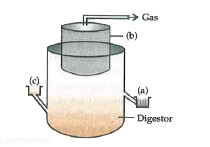In floating gas holder type biogas plant
Digester tank is made 10 - 15 m deep inside soil
Gas holder rises as organic matter is consumed
Monomers formed after decomposition directly undergo methanogenesis
Naturally occurring bacteria in dung are not used
Step-by-Step Text Solution:
1. Understanding the Floating Gas Holder:
- The floating gas holder in a biogas plant is a dome-shaped structure made of steel. Its primary function is to collect and store biogas produced during the anaerobic digestion of organic matter.
2. Functionality of the Gas Holder:
- The gas holder is not fixed; it can float on the surface of the slurry. As biogas is produced, the gas holder rises, allowing for the collection of gas while maintaining contact with the slurry below.
3. Distinction from Digester Tank:
- The digester tank is where the anaerobic digestion occurs, breaking down complex organic materials into simpler compounds. The floating gas holder is not directly related to the depth or construction of the digester tank.
4. Gas Production and Methanogenesis:
- Methanogenesis is a crucial process in biogas production where methane gas is generated from the breakdown of organic matter. This process occurs in the digester tank, not within the gas holder itself.
5. Role of Bacteria:
- The bacteria involved in the production of methane are anaerobic bacteria, which thrive in the absence of oxygen. These bacteria, known as methanogenic bacteria, are essential for the conversion of organic matter into biogas.
6. Conclusion:
- Among the options provided, the statement that "naturally occurring bacteria in dung are not used" is correct. Instead, specific anaerobic bacteria are utilized to produce methane gas in the biogas plant.
- The floating gas holder in a biogas plant is a dome-shaped structure made of steel. Its primary function is to collect and store biogas produced during the anaerobic digestion of organic matter.
- The gas holder is not fixed; it can float on the surface of the slurry. As biogas is produced, the gas holder rises, allowing for the collection of gas while maintaining contact with the slurry below.
- The digester tank is where the anaerobic digestion occurs, breaking down complex organic materials into simpler compounds. The floating gas holder is not directly related to the depth or construction of the digester tank.
- Methanogenesis is a crucial process in biogas production where methane gas is generated from the breakdown of organic matter. This process occurs in the digester tank, not within the gas holder itself.
- The bacteria involved in the production of methane are anaerobic bacteria, which thrive in the absence of oxygen. These bacteria, known as methanogenic bacteria, are essential for the conversion of organic matter into biogas.
- Among the options provided, the statement that "naturally occurring bacteria in dung are not used" is correct. Instead, specific anaerobic bacteria are utilized to produce methane gas in the biogas plant.
Similar Questions
Knowledge Check
One of the following is not a required in the formation of biogas in a biogas plant. This is :
Acow-dungBwaterCoxygenDanaerobic bacteria
Fixed Dome Type Biogas Plant
View SolutionIn a pond , we see plants which are free-floating , rooted-submerged , rooted emergent , rooted with floating leaves . Write the type of plants against each of them .
Plant NameType(a)Hydrilla________(b)Typha______(c)Nymphaea______(d)Lemna_______(e)Vallisnaria_______
View SolutionWrite down a short note on biogas plant and it's significant ?
View SolutionThe diagram below is that of a typical biogas plant. Explain the sequence of events occurring in a biogas plant. Identify a,band c.

View SolutionWhat is biomass ? Name the reaction that takes place in a biogas plant. Write the main constituents of biogas. List two reasons for considering biogas an ideal fuel for domestic use.
View SolutionDraw a diagrammatic sketch of biogas plant and label its various components given below. Gas holder, sludge chamber, Digester, Dung+water chamber. Also briefly explain the utility of this biogas plant.
View SolutionThe diagram above is that of a typical biogas plant. Explain sequence of events in a biogas plant. Identify a, b and c.
View Solution

